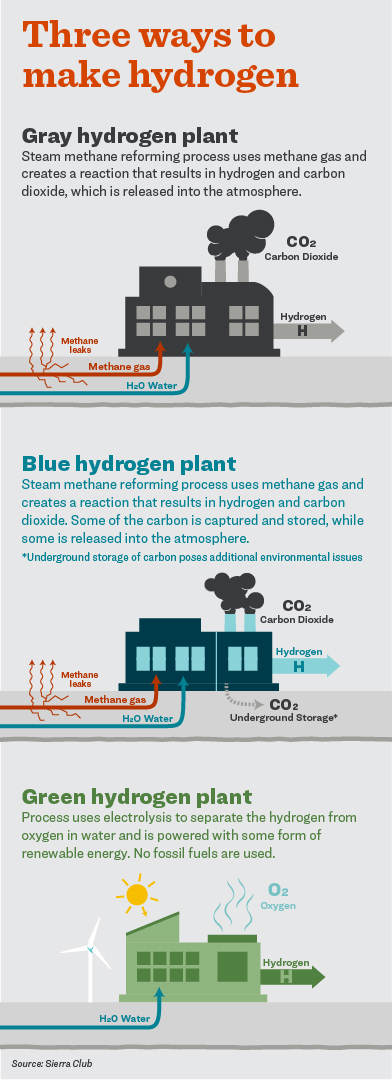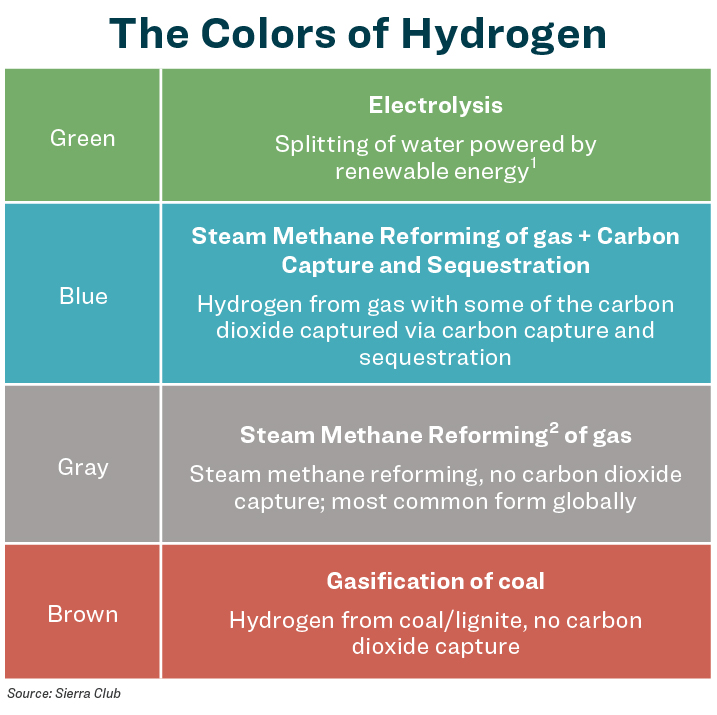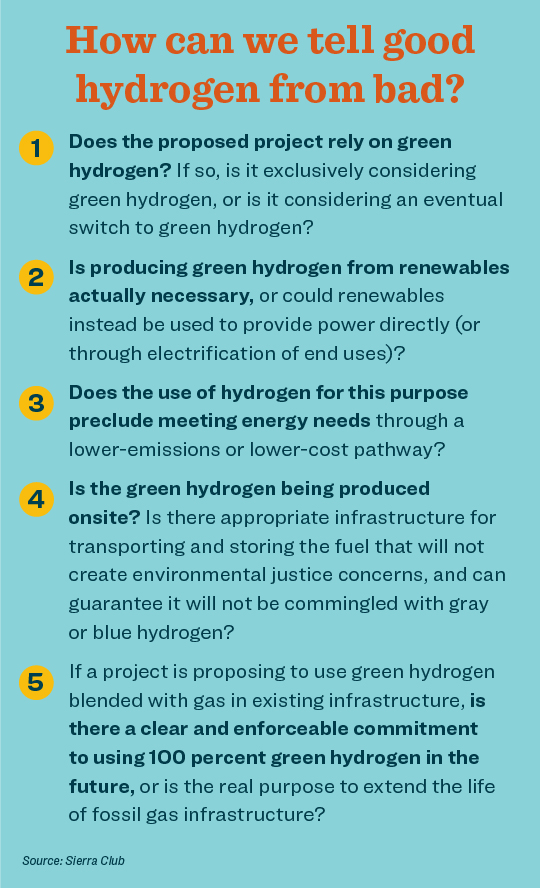The fossil fuel industry is hyping hydrogen of all kinds as a low-carbon replacement for all sorts of uses of fossil fuels—from powering vehicles and heavy industry to heating buildings. In reality, many hydrogen projects will only lock us in to continued fossil fuel use and additional investments in fossil fuel infrastructure.
The Sierra Club only supports the use of green hydrogen—hydrogen made through electrolysis that is powered by renewable energy. Even in the case of green hydrogen, other conditions must be met for its use to be a good idea:
1. Green hydrogen is a promising solution only for uses that cannot otherwise directly rely on clean electricity, which is much more efficient.
2. Green hydrogen should not be used to justify a buildout of facilities that otherwise increase pollution or fossil fuel use.
3. If green hydrogen is being used, the goal should be to switch to 100 percent green hydrogen once the technology is available. We should not support projects that label themselves as “sustainable” because their fuel source includes a small fraction of hydrogen when the lion’s share of it is fracked gas.

How is hydrogen produced?
The fossil fuel industry is generating a ton of interest around hydrogen, presenting it as a solution to the climate crisis and conflating green hydrogen produced from
renewables with hydrogen produced from fossil fuels. Currently, more than 99 percent of the United States’s annual supply of hydrogen, about 10 million metric tons,
comes almost entirely from fossil fuels through “steam methane reforming” (SMR), an energy-intensive process in which methane gas is broken down into hydrogen andcarbon dioxide. Hydrogen produced through SMR is a high-emissions product given the name “gray hydrogen.” In contrast, “green” hydrogen is produced by splitting water into its constituent hydrogen and oxygen components through electrolysis, which is powered by renewable energy. While industry touts hydrogen as a “clean”
solution, globally only 0.02 percent of current hydrogen production is green. “Blue” hydrogen production uses carbon capture and sequestration (CCS) to removecarbon dioxide (CO2) that is emitted during hydrogen production.

What is hydrogen used for?
Buildings: Hydrogen is not a reasonable replacement for gas in heating and cooking appliances in buildings. Electrification is a better option; it is already available, more efficient, more cost-effective, and provides cleaner indoor air than gas. Gas appliances can only handle hydrogen blending of 5 to 20 percent by volume, which severely limits the potential for emissions reductions (as discussed below). Hydrogen use in buildings beyond that level would require all new appliances to be installed for safety and emissions control. Hydrogen is also extremely flammable, and can catch fire even in small concentrations. One study found that if hydrogen were used in homes to replace gas, the annual predicted number of explosions would more than quadruple, which would subsequently increase injuries.
Electric Sector: Hydrogen should largely not be used to generate electricity. Currently, turbine technology can handle between 5 and 20 percent hydrogen blended with gas, with newer technologies, close to commercialization, reaching 30 percent. At these low blending rates, emissions of carbon are only minimally reduced by the use of hydrogen, given hydrogen’s low energy density (more below). There are not yet any commercially available power plants that can burn 100-percent hydrogen. Burning a gas/hydrogen blend would likely increase NOx emissions (more below). Renewable energy should be used directly whenever possible. Hydrogen, even green hydrogen, should not be used to mask existing gas plants as “clean,” nor to justify investment in new gas plants.
Green hydrogen does have some potential uses as a long-term (e.g., multiday to seasonal) energy storage option. It could be produced during periods of excess renewables, using otherwise curtailed power, and then used in fuel cells to balance the grid with no CO2 or NOx emissions. Used this way, green hydrogen could complement batteries as a CO2-free way to replace gas peaker plants, while reducing fracking and methane emissions that come from the production and transport of gas.
Transportation: Hydrogen should not be used to power most vehicles. Electric vehicle options are available, more efficient, and cheaper to purchase and operate than hydrogen vehicles. This is especially true for light-duty cars. Due to advancements in electric vehicle technology, auto companies should be investing in electric cars, not hydrogen cars. School buses, transit buses, and trucks that maintain shorter routes should also be electric, not hydrogen-powered. States should focus on subsidizing electric vehicle infrastructure, not methane-sourced hydrogen infrastructure.
Potential Uses: There are some ways in which green hydrogen use could be part of getting to zero emissions economy-wide, but they are likely most appropriate for hard-to-decarbonize sectors, like long-haul freight trucking. Green hydrogen has the potential to help store intermittent renewable energy; be converted to a “zero-emissions” fuel for maritime shipping and aviation; be used in high-heat industrial processes that cannot otherwise be electrified; or, be used as a feedstock in some industrial processes, like steel production.
Hydrogen is an inefficient use of clean electricity
It is always more efficient to use renewable power directly than to convert renewable energy to hydrogen for use as an energy source. This is true across sectors and end uses. Using renewables to produce hydrogen is about 20 to 40 percent less efficient than using renewable energy directly, when direct use is feasible. For this reason, the Sierra Club would always prefer to use renewable electricity directly where possible. Potential uses for green hydrogen should be limited to cases in which the renewable energy cannot be used directly or stored effectively.
Hydrogen’s climate benefits are limited
Green hydrogen does not produce greenhouse gases, so if it is used to displace other sources of energy that do, it can have a climate benefit. The potential climate benefit of a green hydrogen solution must be assessed against other reasonable alternatives. For example, injecting a small amount of green hydrogen into a methane gas stream reduces a small amount of the methane that would otherwise be burned, and the subsequent climate impact of that methane. However, replacing that methane gas stream with an electrification of end uses (i.e., electrified buildings) would do far more to reduce planet-warming emissions.
The gas industry touts “blue hydrogen” as a climate-friendly solution because theoretically, carbon dioxide is removed and stored during the hydrogen production process. However, recent research indicates that producing blue hydrogen does not actually reduce climate emissions compared to using methane gas. In fact, using hydrogen made from gas with or without CCS at a power plant actually produces more emissions than burning gas alone at that power plant, due to the emissions intensity of creating blue or gray hydrogen. Even if leakage is reduced to 1.5 percent (an optimistic assumption), one study found that using blue hydrogen still created more emissions than using gas. This means that as a power plant uses increasing amounts of blue hydrogen mixed with gas, its lifecycle emissions will actually increase.
Hydrogen does not produce carbon emissions when burned at end use. If hydrogen is blended with methane gas at a power plant, the carbon emissions from that power plant will be lower. However, hydrogen has a lower energy density than gas, meaning it takes a larger volume of blended hydrogen and methane to provide the same energy input as an equal volume of gas. Because of this, a blend of 30 percent hydrogen and 70 percent gas by volume only results in a 13-percent decrease in carbon emissions at end-use.
Additionally, any hydrogen leakage could undermine the benefits of green hydrogen and increase the lifecycle emissions of other types of hydrogen because hydrogen is an indirect greenhouse gas—meaning it combines with other compounds in the atmosphere to cause warming—that is five times more potent than carbon dioxide over a 100-year timeframe.
Hydrogen produces pollution
When hydrogen is combusted, it does not produce carbon emissions, but it does produce NOx emissions up to six times worse than those released by methane combustion. NOx can cause serious health effects, including asthma and increased chance of respiratory infections; NOx is also a precursor to particulate matter and ozone, which harm the respiratory system. While there are methods of controlling NOx emissions at gas power plants, those technologies are only effective at controlling NOx at a blend of 30 percent hydrogen or less.
Hydrogen used in fuel cells does not result in carbon emissions, only electricity, water, and heat. The production of hydrogen through steam methane reforming (SMR) produces emissions that are known to be harmful, including NOx, particulate matter, carbon monoxide, and volatile organic compounds (VOCs).
How is hydrogen stored and transported?
Pipelines: About 96 percent of existing gas transmission pipelines in the US are steel. Steel is susceptible to “hydrogen embrittlement,” which is the loss of strength of the metal due to hydrogen entering into tiny spaces in the metal, causing the pipe to crack. This makes nearly all of the current transmission pipelines in the US unsafe for transporting hydrogen in high volumes. Researchers estimate that hydrogen can only comprise about 20 percent by volume, or 7 percent of energy content, before it creates safety hazards in unmodified pipelines. Safe transportation of hydrogen requires either plastic pipelines with a coating to prevent hydrogen leakage or substantial modification of steel pipes. Today, plastic pipelines comprise a very small portion of the existing transmission pipeline system, but over half of distribution pipelines are plastic. There are currently 1,600 miles of hydrogen pipelines in the US (primarily along the Gulf Coast); for comparison, there are 3 million miles of methane gas pipelines. Replacing existing pipelines with new infrastructure that is safe for hydrogen would be very expensive. Additionally, current leak detection systems are designed for gas, not hydrogen, and would have to be upgraded to detect hydrogen, a colorless, tasteless, odorless gas.
Storage: Hydrogen is less dense than gas, which makes it particularly hard to store. Hydrogen can be stored in bulk in salt caverns, which are limited to a few locations in the U.S. For long-term storage, hydrogen must be converted to a liquid, a process which can be more expensive than producing the hydrogen itself. Storing hydrogen as a gas requires high-pressure tanks, and storing it as a liquid requires maintaining cryogenic (very cold) temperatures. If hydrogen were to replace gas in the global economy, it would require 3 to 4 times more storage infrastructure, at a cost of $637 billion by 2050, to provide the same level of energy security as the world would have with gas.
Some projects propose converting hydrogen to liquid ammonia for storage and transportation, then converting the ammonia back to hydrogen at the site of power generation. The energy for this process is about equal to that of cooling and liquefying hydrogen, but far more infrastructure exists for safely handling, transporting, and storing ammonia.
Other Infrastructure: Since hydrogen is less dense than gas, adding hydrogen to gas requires larger total volumes to produce the same amount of energy. Additional volume means additional compressor stations to move comparable amounts of energy through the pipeline system, resulting in a host of environmental justice, health, and climate issues. Hydrogen blending would also impose the cost of creating different metering systems at the city gate and residential levels.
How much water does hydrogen use?
Generating 1 kilogram (kg) of hydrogen through electrolysis uses 9 kg of water. For context, supplying hydrogen for a 288-megawatt power plant using 100-percent hydrogen would require the equivalent of an Olympic-size swimming pool of water every 12 hours. The power plant would need additional water for cooling, which would increase the total water usage to 15 to 20 kg of water per kg of hydrogen. While this is a large amount of water, and could be problematic for water-scarce areas, hydrogen’s water requirements are much less than the amount of water required for the extraction and processing of fossil fuels today.

Hydrogen and Environmental Injustice
Many existing and proposed hydrogen projects are located near existing oil, gas and chemical facilities, which are disproportionately sited in communities of color. New hydrogen projects must be evaluated to ensure that they are not simply an attempt to prop up the fossil fuel industry or extend the lifetime of fossil fuel projects. Oil and gas production, transport and burning has significant environmental justice impacts, and hydrogen buildout must not make these impacts worse. Safe storage (of either ammonia or hydrogen) must be considered, especially at retrofitted facilities. Finally, any project that proposes combusting hydrogen must not increase NOx emissions and other pollution in fenceline communities.
Hydrogen is costly compared to clean electricity
“Currently, conventional fossil hydrogen costs between $1.25/kilogram and $2/kilogram in the United States, while green hydrogen costs between $2.50/kilogram and $4.50/kilogram. Three sets of analysts —at BloombergNEF, Wood Mackenzie, and McKinsey—have recently found that green hydrogen could become cost-competitive by 2030 as economies of scale drive down the cost of electrolyzers and the price of wind and solar power continues to fall.” Industry has been pushing for blue hydrogen development with the dubious argument that investing in sub-optimal (or harmful) hydrogen infrastructure today might allow the deployment of green hydrogen in the future. In reality, the cost of green hydrogen will decline based on advancements in electrolyzer technology and continued reduction in the costs of wind and solar power, not based on gray or blue hydrogen development.

